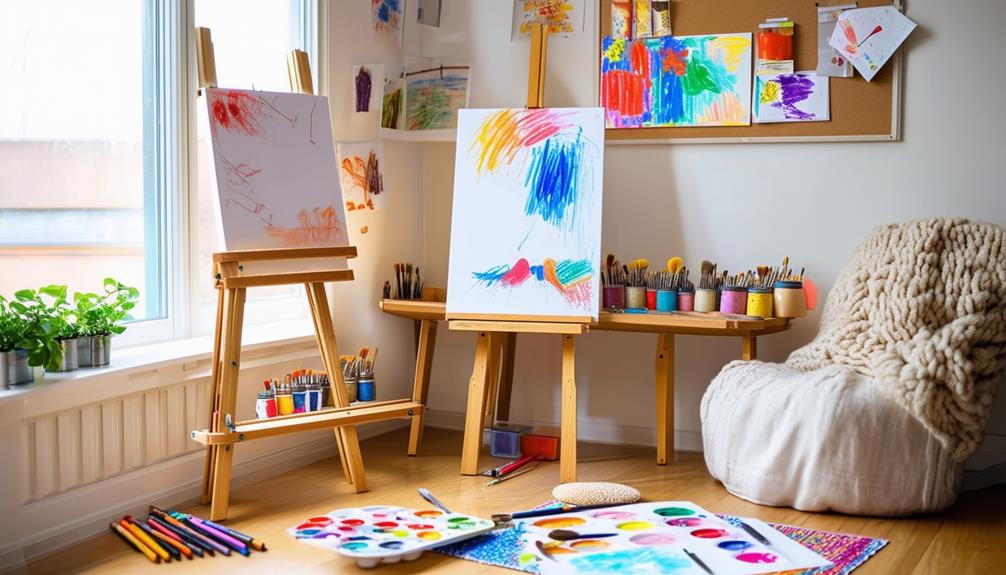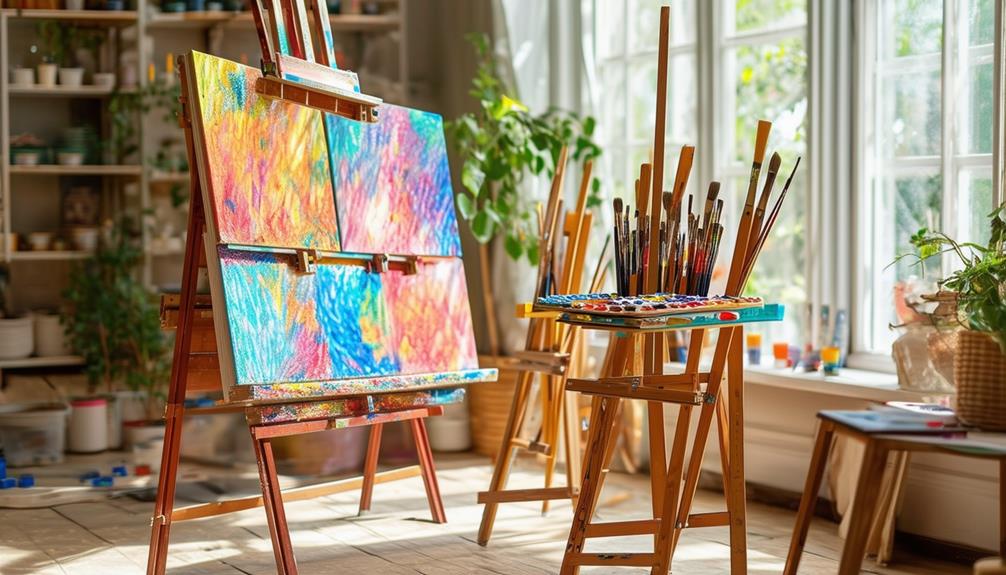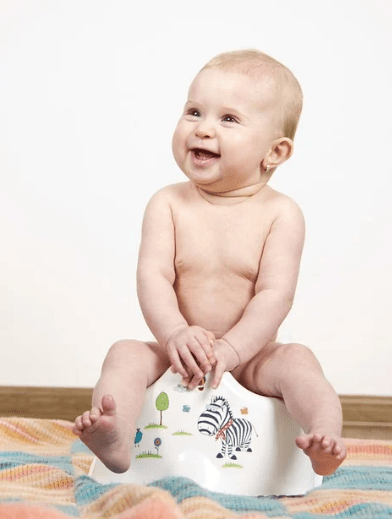How to Create a Mini Art Studio for Your Child

Creating a mini art studio for your child starts with selecting a well-lit, easy-to-clean spot near a water source. It's important to choose furniture and storage solutions that are suitable for your child's height and needs. An organized and thoughtfully arranged space can inspire creativity while maintaining order. But how do you choose the best supplies, and what essential components are needed to make the space both functional and inviting? Let's explore the steps to ensure your child has a motivating and practical area to create their artworks.
Choosing the Right Location
Selecting the right spot for your child's mini art studio is crucial for nurturing creativity and managing messes effectively. Opt for a space with ample natural light to enhance your child's creativity and reduce eye strain. Natural light highlights colors and maintains an inviting atmosphere, which is essential for inspiring kids to immerse themselves in their art projects.
Additionally, consider a location with easy-to-clean flooring. Art activities can get messy, so having a surface that's simple to wipe will save you time and hassle. If the floor isn't tiled, you can use a drop cloth to protect it from spills and splatters.
Ensure the art studio is compact and easily accessible, allowing your child to independently access their art supplies and begin working without constant assistance. Proximity to water sources and cleaning supplies is also critical for making cleanup after art sessions swift and convenient.
Essential Furniture and Storage
To create an inviting and practical art studio for your child, start with functional furniture like the IKEA Children's Table & 2 Chairs Set. Organize art supplies with smart solutions, such as the KidKraft Art Table with Drying Rack. Enhance storage with items that keep supplies accessible and inspiring, ensuring the space remains tidy and conducive to creativity.
Selecting Functional Furniture
Creating a functional and inspiring mini art studio for your child involves selecting the right furniture and storage solutions to foster creativity and independence. Start with appropriately sized children's tables and chairs from reliable brands like IKEA or Melissa & Doug. Consider options like Montessori cube chairs or adjustable desks, which offer versatility as your child grows.
Organizing art supplies is essential for maintaining a tidy space and ensuring easy access to materials. Opt for storage solutions such as pine storage units from IKEA or KidKraft art tables with built-in drying racks. Avoid tiered models that may be hard for children to reach; instead, choose shelves and bins at your child's level to promote independence.
Adding a rug, such as the Hulsig Home Living Room Rug, can protect your floors and add a decorative touch to the studio. By combining the right furniture and storage solutions, you can create a functional and inspiring environment that allows your child to focus on their artistic endeavors without distraction.
Organizing Art Supplies
Organizing your child's art supplies is essential for maintaining a tidy and functional creative space. Start by selecting developmentally appropriate furniture like the IKEA Children's Table & 2 Chairs Set or the Montessori Cube Chair. These pieces provide a cozy and practical workspace where your child can freely express their creativity.
Utilize storage options such as the IKEA Children Pine Storage or the KidKraft Art Table with Drying Rack. These choices help keep art materials organized and easily accessible, promoting your child's independence and creativity. Ensure that storage is within reach so your little artist can easily find what they need.
Consider placing a Hulsig Home Living Room Rug in the art studio. It provides warmth, protects the floor, and adds a decorative element to the area. A comfortable and inviting setting can inspire your child's artistic endeavors.
When choosing furniture and storage solutions, prioritize durability and functionality. Opt for items that can withstand the impact of enthusiastic art projects. Well-organized and easily reachable storage solutions help create an art studio where your child's creativity can flourish without the mess.
Maximizing Storage Solutions
Maximizing storage solutions can transform a cluttered area into an inspiring mini art studio for your child. Essential furniture like the IKEA Children's Table & 2 Chairs Set or the Melissa & Doug Wooden Table and 2 Chairs Set provides a sturdy foundation for a creative space.
To keep art supplies organized and accessible, consider options such as the IKEA Children's Pine Storage and the KidKraft Art Table with Drying Rack. These pieces offer designated spots for every supply, helping to manage the chaos often associated with a kids' art studio.
Accessibility is crucial for fostering independence and creativity. The Montessori Cube Chair and the Hape Early Necessary Art Play Station and Stool Set are excellent choices that allow your child to reach their materials effortlessly.
Tiered storage solutions can keep everything within arm's reach and neatly organized. Adding a cozy rug like the Hulsig Home Living Room Rug can protect your floors and add warmth to the studio. By thoughtfully combining these elements, you create a functional and inspiring space for your budding artist.
Stocking Up on Art Supplies

When stocking up on art supplies, ensure you have essential items like pencils, paper, paints, and brushes. Opt for high-quality, age-appropriate materials that align with your child's interests and are budget-friendly. Keep your supplies organized to foster creativity and ensure easy access.
Essential Art Supplies
Stocking up on essential art supplies means investing in high-quality, age-appropriate materials like Lyra or Prismacolor pencils, which enhance your child's sensory experience. When setting up an art space for children, it's important to offer a range of materials to ignite their creativity and keep them engaged. Consider adding watercolors, various brush types, and quality paper to their art supplies to provide a comprehensive artistic toolkit.
Incorporating sustainable art practices can be both enjoyable and educational. Recycled materials such as old magazines and cardboard can be transformed into beautiful works of art, teaching children the importance of reusing materials while expanding their creative horizons.
Include a selection of tools to support different techniques and styles. Soft and firm bristle brushes in various sizes and shapes allow your child to experiment with different strokes and textures. Regularly updating and expanding your child's art supplies based on their evolving interests will keep their creative spark alive. By providing a well-rounded collection of essential art supplies, you're setting the stage for endless artistic exploration and fun.
Age-Appropriate Materials
Selecting age-appropriate art materials ensures your child can safely explore their creativity while developing essential skills. For young children, opt for non-toxic crayons, washable markers, and chunky paintbrushes. These tools are safe, easy to handle, and durable. Including safety scissors, glue sticks, and colorful construction paper helps develop fine motor skills and encourages creative expression.
For sensory exploration, choose finger paints and modeling clay. These materials allow children to experiment with textures, make a mess, and enjoy a full sensory experience. Beginner-friendly watercolor sets are great for introducing basic painting techniques and fostering an early love for art. Art kits tailored for preschoolers or toddlers often come with a variety of supplies, making it easy to offer a range of creative activities.
Here's a handy table to guide your choices:
| Age Group | Recommended Materials |
|---|---|
| Toddlers | Non-toxic crayons, finger paints, chunky paintbrushes |
| Preschoolers | Washable markers, modeling clay, glue sticks |
| Early Elementary | Safety scissors, colorful construction paper, watercolor sets |
| All Ages | Art kits with a variety of safe, age-appropriate supplies |
Ensuring materials are easy to use and safe for your child's age keeps their creative exploration both enjoyable and secure.
Affordable Options
Finding materials suitable for your child's art projects is just the first step; now let's explore cost-effective ways to stock up on supplies without straining your budget. Start by purchasing art supplies in bulk or in sets, which can offer significant savings. Opt for affordable, non-toxic, and washable paints, crayons, and markers to ensure your child's safety.
Don't overlook household items as potential art materials. Repurposed materials like cardboard, newspapers, and old magazines can be transformed into creative projects. This approach is both eco-friendly and cost-effective, providing more value for your money.
Explore discount stores, dollar stores, or online retailers for budget-friendly art supplies. These stores often offer a wide range of materials at lower prices compared to specialty shops. Additionally, keep an eye out for sales, coupons, and clearance items to build a collection of art materials without exceeding your budget.
Setting Up an Easel
When setting up an easel for your child's mini art studio, choose a sturdy and versatile option like the Melissa & Doug Deluxe Wooden Standing Art Easel. This durable easel will serve as the centerpiece of the studio, offering a space where kids can freely express their creativity. Look for an easel with multiple functionalities, such as a double-sided surface with a whiteboard on one side and a chalkboard on the other, to provide diverse ways for your child to explore their artistic ideas.
For smaller spaces, consider a compact option like the Double Sided Magnetic Tabletop Easel. This desktop easel fits well in limited areas while still offering the benefits of a dedicated art station.
Enhance the easel setup with essentials like paper, a plastic tray for holding supplies, and various artist accessories. These additions will make the art studio more functional and inviting. Place the easel in a well-lit area to inspire creativity and support artistic exploration. By making the easel the focal point, you create a mini art studio where your child's imagination can flourish.
Creating Drying Spaces

With the easel now set up, it's crucial to establish drying spaces to keep your child's artwork safe and organized. One efficient method is to use a clothes drying rack or a dedicated paint drying rack. These options offer ample space to hang and dry multiple pieces simultaneously, ensuring each creation gets the attention it deserves without cluttering your art studio.
For smaller artworks, consider using rugs or plastic container lids as drying surfaces. These can be easily moved and positioned under natural light, which is ideal for drying. Natural light not only accelerates the drying process but also helps preserve the artwork's vibrant colors.
To maintain an organized and functional art studio, designate a specific area for drying artwork. This dedicated space will help prevent accidental smudging or damage to wet pieces. Proper drying spaces are practical and allow for effective showcasing of your child's creations. By prioritizing these drying areas, you'll ensure that every masterpiece is preserved and ready for display. A well-organized space fosters creativity and enhances the artistic process for your child.
Incorporating Outdoor Spaces
Outdoor areas often provide a revitalizing and motivating setting for your child's artistic endeavors. Utilizing outdoor spaces can enrich your child's creativity and enjoyment, particularly during warmer seasons. Setting up a dedicated outdoor art studio can further stimulate their imagination and artistic exploration.
To establish this designated outdoor art studio, consider using the versatile IKEA RASKOG cart. Its three tiers are ideal for organizing art supplies, and its mobility allows for easy transition between indoor and outdoor areas, ensuring all necessary materials are always within reach. Attach magnetic jars to the cart to keep small art supplies like beads, buttons, and brushes organized and accessible. This way, your child can focus on their art activities without constantly searching for tools.
Incorporating outdoor areas into your child's art routine offers a new perspective and a natural backdrop that can spark their creativity. Set up a simple table and chairs in the backyard or use a portable easel. Ensure the area is shaded to protect them from the sun, and use sturdy, washable materials to keep everything clean and organized. This outdoor art studio will be a sanctuary for your child's artistic endeavors.
Encouraging Creativity

Encouraging creativity in your child begins with providing a diverse array of art materials that inspire exploration and experimentation. By offering a variety of supplies, you motivate your child to try new techniques and discover their artistic preferences. Consider designating a specific area in your home for your child to create. This doesn't have to be a large room; even a small corner with a table and shelves can be sufficient.
Having an easily accessible assortment of materials is crucial for fostering spontaneous creativity. Here's an organized way to store art supplies:
| Art Supplies | Storage Ideas |
|---|---|
| Crayons and Markers | Small plastic containers |
| Paints and Brushes | Cubbies or drawers |
| Papers and Canvases | Stackable trays |
| Glue and Scissors | Bins with dividers |
| Clay and Playdough | Airtight containers |
Embrace the messiness that comes with art. Allow your kids to access the materials freely without fear of making a mess. This freedom is essential for authentic self-expression. Unrestricted exploration is where true creativity flourishes. Encouraging your child this way will help them build confidence in their artistic abilities.
Maintaining Organization
To maintain organization in your child's mini art studio, utilize wall shelves, clipboards, and jars to keep supplies orderly and accessible. Wall shelves can hold jars filled with markers, crayons, and paintbrushes, making it easy for your child to find what they need. Clipboards are perfect for displaying finished artwork or keeping drawing paper neat and ready for use.
Incorporate clothes pegs and ropes to hang up their masterpieces, which keeps the space tidy and allows your child to proudly display their work. Use washi tape to label different sections or jars, ensuring everything has its designated spot. This helps your child easily identify where to put away each item, fostering a sense of responsibility and care.
Ensure the area is easy to clean by using washable mats or table covers, and encourage your child to clean up after each session. Keeping the space tidy will help maintain their creativity and respect for their materials. Remember, an organized art studio with intentional lighting and accessible supplies will make the creative process enjoyable and stress-free for both you and your child.




